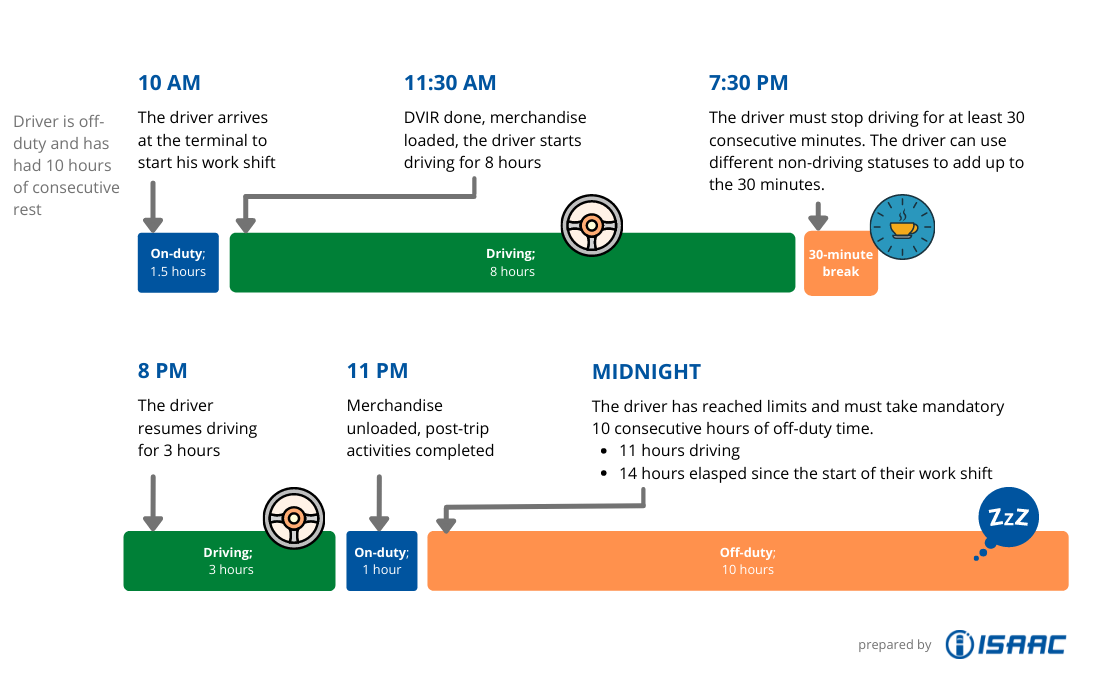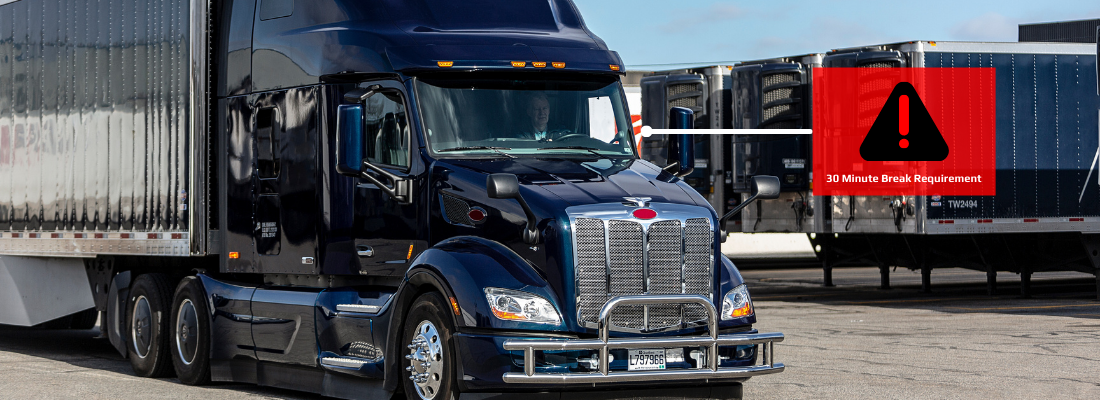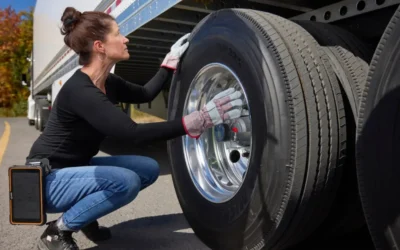Hours-of-service regulations defined
Hours-of-Service (HOS) regulations are issued by the Federal Motor Carrier Safety Administration (FMCSA) in the United States. They specify the maximum amount of time drivers are permitted to be on duty, including driving time and specifies the number and length of rest periods. The HOS’s primary purpose is to help ensure overall road safety, prevent accidents caused by driver fatigue, and improve drivers’ quality of life.
Who must comply with HOS rules?
Most carriers and drivers operating commercial motor vehicles (CMV) must comply with HOS regulations found in article 49 CFR 395. A CMV is a vehicle that is used for business, is involved in interstate commerce and fits any of these descriptions:
- Weighs 10,001 lbs or more
- Has a gross vehicle weight rating or gross combination weight rating of 10,001 lbs or more
- Is designed or used to transport 16 or more passengers (including the driver) not for compensation
- Is designed or used to transport 9 or more passengers (including the driver) for compensation
- Is transporting hazardous materials in a quantity requiring placards
HOS rules overview for property-carrying drivers
11-Hour Driving Limit
A driver may drive a maximum of 11 hours after 10 consecutive hours off duty.
14-Hour Limit
A driver may not drive beyond the 14th consecutive hour after coming on duty. The driver can’t resume driving unless they have taken 10 consecutive hours off-duty. Off-duty time does not extend the 14-hour period.
30-Minute Driving Break
Drivers must stop driving if more than 8 hours of driving have passed without at least a consecutive 30-minute interruption of driving. The break (or interruption of driving time) can be satisfied by any non-driving activity or a combination of non-driving activities of 30 consecutive minutes.
10 minutes off-duty + 20 minutes on-duty, not driving = 30 consecutive minutes break
70-Hour Limit (cycle)
A driver may not drive after cumulating 70 hours on duty in 8 consecutive days. A driver may restart an 8 consecutive day period at any time after taking 34 or more consecutive hours off duty.
Looking for the Canadian HOS rules overview? Check out this blog: Understanding the HOS Rules and Exemptions in Canada
A day in the life of a truck driver respecting the U.S. HOS regulations

Commonly used provisions
Here’s a quick overview of commonly used provisions of the hours-of-service regulations to provide greater flexibility for drivers while maintaining safety on the roads.
Short-haul exception
Drivers using the short-haul exception are not required to fill out a log with a graph grid or use an electronic logging device (ELD). To be allowed to use the short-haul exception, they must:
- operate within a 150 air-mile radius of the normal work reporting location
- not exceed a maximum duty period of 14 hours
- start and end their shift at the same work reporting location
- have at least 10 hours off between shifts
The motor carrier must record the driver’s time in, time out, and the total number of hours per day. Records must be maintained for 6 months. For new hires or drivers used intermittently, the time record must include the total time for the 7 preceding days.
Adverse driving conditions
Drivers are allowed to extend the 11-hour maximum driving limit and 14-hour driving window by up to 2 hours when adverse driving conditions are encountered.
Adverse driving conditions means snow, ice, sleet, fog, or other adverse weather conditions or unusual road or traffic conditions that were not known, or could not reasonably be known, to:
- a driver immediately prior to beginning the duty day or immediately before beginning driving after a qualifying rest break or sleeper berth period, or
- a motor carrier immediately prior to dispatching the driver
Note that drivers cannot use the adverse driving conditions exception to cover delays caused by: detention time, breakdowns, enforcement inspections, loading or unloading.
Sleeper berth provision
Drivers may split their required 10-hour off-duty period, as long as:
- One off-duty period (in or out of the sleeper berth) is at least 2 hours long and
- The other off-duty period involves at least 7 consecutive hours spent in the sleeper berth.
- All sleeper berth pairings add up to at least 10 hours.
When used together, neither period counts against the maximum 14- hour driving window
When using the sleeper berth provision, the order of the qualifying breaks does not matter—the break of “at least 2 hours” can fall before or after the sleeper berth period of “at least 7 hours.”
Your partner in staying compliant
Understanding the HOS rules is one thing. Staying compliant is another. Using a reliable and driver-friendly ELD such as ISAAC’s helps ensure your fleet’s compliance. Your drivers’ logs are updated automatically with the correct duty status as they drive and perform activities, all in sync with their trip sheet. Drivers also receive real-time notifications to avoid HOS violations.
If you’re looking for an ELD solution, but are not sure what questions to ask the provider, watch our webinar hosted jointly by the Truckload Carriers Association (TCA).
Disclaimer: The information presented in this post is intended for informational purposes only and should not be construed as legal advice.

About the author
Melanie Simard
Director Compliance, Client Service & Technical Support, ISAAC Instruments
Melanie Simard is Director of Compliance, Client Service & Technical Support at ISAAC. She brings these three groups together to ensure ISAAC clients receive best-in-class service and support, and to demystify all questions relating to regulatory compliance. She is passionate about this last subject, and well attuned to the kind of support ISAAC users need, as she was on that side of the equation before joining ISAAC. With over 20 years in the trucking industry, her field experience as a driver, dispatcher, compliance manager—not to mention an ISAAC user—the trucking DNA she brings to the table is a valuable asset to both ISAAC and its clients.









